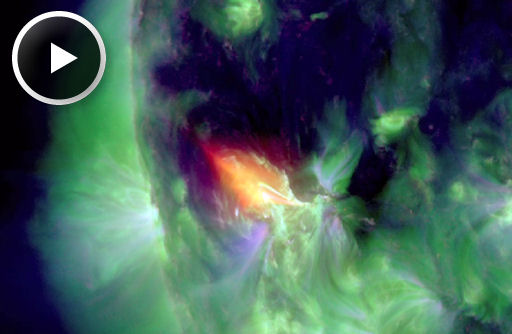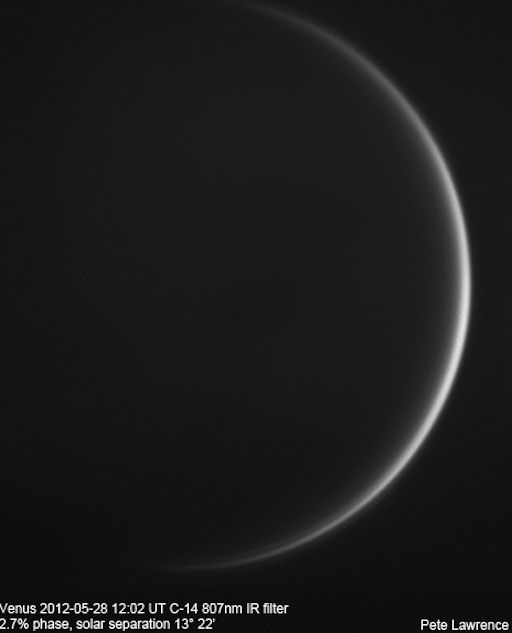ASTEROID FLYBY: Today, May 28th, newly-discovered asteroid 2012 KP24 is flying past Earth only one-tenth the distance to the Moon. Amateur astronomer Rolando Ligustri photographed the 26-meter space rock during the early hours of May 28th when it was about 350,000 km from our planet: image. Measurements of the asteroid's orbit confirm that there is no danger of a collision with Earth.
AR1492 ERUPTS, CME TARGETS MARS: The magnetic canopy of sunspot AR1492 erupted on May 27th, producing a long-duration C3-class solar flare and hurling a coronal mass ejection (CME) toward Mars. NASA's Solar Dynamics Observatory recorded the explosion's extreme UV flash:
Note the shadowy wave billowing away from the blast site. That's the 'solar tsunami' so often associated with the ejection of CMEs.
Analysts at the Goddard Space Weather Lab say the CME from this blast will hit the Mars Science Lab spacecraft (containing Mars rover Curiosity) on May 31st at 0100 UT followed by Mars itself about 10 hours later. Earth could receive a glancing blow from the cloud on May 29th; more likely, though, it will completely miss.
VENUS SLENDERIZES: As Venus approaches the sun for a much-anticipated transit on June 5-6, the second planet is turning its night side toward Earth. Seen through a telescope, all that remains of Venus is a vanishingly-slender crescent:
Pete Lawrence of Selsey, UK, took the picture in broad daylight on May 28th: "This beautiful planet has just slipped below 2.7% phase on it's way to the historic transit on June 5/6. We had clear sunny weather today, so I was able to capture Venus in daylight conditions."
In words and a picture, he explains how he accomplished the daytime shot: "Sun shields were erected to shade the main telescope. In addition, the main tube was wrapped in aluminium foil in an attempt to keep it cool and prevent internal air currents from distorting the view. Note the proper solar filter--i.e. not foil!--covering the full aperture."
The crescent of Venus could soon become a ring. When Venus is less than few degrees away from the sun, the horns of the crescent soetimes reach around and touch, producing a complete annulus. The effect is caused by sunlight-scatteriing particles in upper layers of Venus's atmosphere. It is very difficult to observe, and often only black-belt astrophotographers are able to record the phenomenon.
Keep an eye on SpaceWeather's realtime photo gallery to see how Venus shape-shifts in the days ahead.

![]()
Solar wind
speed: 413.0 km/sec
density: 10.2 protons/cm3
explanation | more data
Updated: Today at 1805 UT
![]()
X-ray Solar Flares
6-hr max: B7 1249 UT May28
24-hr: B7 1249 UT May28
explanation | more data
Updated: Today at: 1800 UT
![]()
![]()
![]()
Daily Sun: 28 May 12
![]()
![]()
Sunspot 1492 poses a threat for C-class flares. Credit: SDO/HMI
![]()
![]()
![]()
Sunspot number: 83
What is the sunspot number?
Updated 27 May 2012
Spotless Days
Current Stretch: 0 days
2012 total: 0 days (0%)
2011 total: 2 days (<1%)
2010 total: 51 days (14%)
2009 total: 260 days (71%)
Since 2004: 821 days
Typical Solar Min: 486 days
Updated 27 May 2012
The Radio Sun
10.7 cm flux: 111 sfu
explanation | more data
Updated 27 May 2012
![]()
![]()
![]()
Current Auroral Oval:
![]()
Switch to: Europe, USA, New Zealand, Antarctica
Credit: NOAA/POES
![]()
![]()
![]()
Planetary K-index
Now: Kp= 3 quiet
24-hr max: Kp= 3 quiet
explanation | more data
![]()
Interplanetary Mag. Field
Btotal: 5.7 nT
Bz: 3.5 nT south
explanation | more data
Updated: Today at 1806 UT
![]()
![]()
![]()
Coronal Holes: 28 May 12
![]()
![]()
A solar wind stream flowing from this coronal hole should blow just north of Earth on ~May 31. Credit: SDO/AIA.






